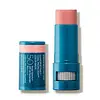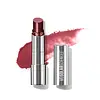Colorescience Sunforgettable Total Protection Color Balm SPF50 PA++++ Versus MDSolarSciences Hydrating Sheer Lip Balm SPF 30
What's inside
What's inside
 Key Ingredients
Key Ingredients

 Benefits
Benefits

 Concerns
Concerns

 Ingredients Side-by-side
Ingredients Side-by-side

Zinc Oxide 12.5%
Cosmetic ColorantJojoba Esters
EmollientC26-28 Alkyl Dimethicone
Skin ConditioningButyloctyl Salicylate
Skin ConditioningSqualane
EmollientC18-36 Acid Triglyceride
EmollientPolymethylsilsesquioxane
Glyceryl Dibehenate
EmollientSynthetic Fluorphlogopite
Euphorbia Cerifera Wax
Tridecyl Salicylate
Skin ConditioningVp/Eicosene Copolymer
Methylpropanediol
SolventTribehenin
EmollientLecithin
EmollientMica
Cosmetic ColorantDimethiconol
EmollientCopernicia Cerifera Wax
Glyceryl Behenate
EmollientCaprylyl Glycol
EmollientPhysalis Angulata Extract
Skin ProtectingCaprylic/Capric Triglyceride
MaskingBisabolol
MaskingTocopheryl Acetate
AntioxidantPhenylpropanol
MaskingDimethylmethoxy Chromanol
AntioxidantDimethicone
EmollientTocopherol
AntioxidantTin Oxide
AbrasiveIron Oxides
Titanium Dioxide
Cosmetic ColorantCI 77891
Cosmetic ColorantZinc Oxide 12.5%, Jojoba Esters, C26-28 Alkyl Dimethicone, Butyloctyl Salicylate, Squalane, C18-36 Acid Triglyceride, Polymethylsilsesquioxane, Glyceryl Dibehenate, Synthetic Fluorphlogopite, Euphorbia Cerifera Wax, Tridecyl Salicylate, Vp/Eicosene Copolymer, Methylpropanediol, Tribehenin, Lecithin, Mica, Dimethiconol, Copernicia Cerifera Wax, Glyceryl Behenate, Caprylyl Glycol, Physalis Angulata Extract, Caprylic/Capric Triglyceride, Bisabolol, Tocopheryl Acetate, Phenylpropanol, Dimethylmethoxy Chromanol, Dimethicone, Tocopherol, Tin Oxide, Iron Oxides, Titanium Dioxide, CI 77891
Butyl Methoxydibenzoylmethane 3%
UV AbsorberEthylhexyl Salicylate 5%
UV AbsorberHomosalate 10%
Skin ConditioningPersea Gratissima Oil
Skin ConditioningButyrospermum Parkii Butter
Skin ConditioningHydrogenated Soybean Oil
EmollientParaffin
PerfumingRicinus Communis Seed Oil
MaskingOctyldodecanol
EmollientOlea Europaea Fruit Oil
MaskingButyloctyl Salicylate
Skin ConditioningHydrogenated Vegetable Oil
EmollientJojoba Esters
EmollientMicrocrystalline Wax
Emulsion StabilisingStearic Acid
CleansingHelianthus Annuus Seed Wax
Skin ConditioningSqualane
EmollientPolyglycerin-3
HumectantTetrahexyldecyl Ascorbate
AntioxidantTocopheryl Acetate
AntioxidantAscorbyl Palmitate
AntioxidantTocopherol
AntioxidantRhus Verniciflua Peel Wax
Acacia Decurrens Flower Wax
EmollientSorbitan Oleate
EmulsifyingSynthetic Fluorphlogopite
CI 77891
Cosmetic ColorantIron Oxides
CI 77491
Cosmetic ColorantCI 77492
Cosmetic ColorantCI 77499
Cosmetic ColorantCI 15850
Cosmetic ColorantCI 45380
Cosmetic ColorantButyl Methoxydibenzoylmethane 3%, Ethylhexyl Salicylate 5%, Homosalate 10%, Persea Gratissima Oil, Butyrospermum Parkii Butter, Hydrogenated Soybean Oil, Paraffin, Ricinus Communis Seed Oil, Octyldodecanol, Olea Europaea Fruit Oil, Butyloctyl Salicylate, Hydrogenated Vegetable Oil, Jojoba Esters, Microcrystalline Wax, Stearic Acid, Helianthus Annuus Seed Wax, Squalane, Polyglycerin-3, Tetrahexyldecyl Ascorbate, Tocopheryl Acetate, Ascorbyl Palmitate, Tocopherol, Rhus Verniciflua Peel Wax, Acacia Decurrens Flower Wax, Sorbitan Oleate, Synthetic Fluorphlogopite, CI 77891, Iron Oxides, CI 77491, CI 77492, CI 77499, CI 15850, CI 45380
Alternatives
Ingredients Explained
These ingredients are found in both products.
Ingredients higher up in an ingredient list are typically present in a larger amount.
Butyloctyl Salicylate is a chemical UV filter structurally similar to octisalate. It is a photostabilizer, SPF booster, emollient and solvent. This ingredient helps evenly spread out ingredients.
According to a manufacturer, it is suitable for pairing with micro Titanium Dioxide, Zinc Oxide, and pigments.
Photostabilizers help stabilize UV-filters and prevents them from degrading quickly.
Learn more about Butyloctyl SalicylateCi 77891 is a white pigment from Titanium dioxide. It is naturally found in minerals such as rutile and ilmenite.
It's main function is to add a white color to cosmetics. It can also be mixed with other colors to create different shades.
Ci 77891 is commonly found in sunscreens due to its ability to block UV rays.
Learn more about CI 77891Jojoba Esters is a wax created from Jojoba oil. It is an emollient and film-forming ingredient. In bead form, it is an exfoliator.
This ingredient has high oxidative stability, meaning it doesn't break down when exposed to oxygen.
Its similarity to our skin's natural oils makes it a great emollient. Emollients help soften and soothe our skin by creating a barrier on top. This barrier helps trap moisture in, keeping skin hydrated.
It is created using either the hydrogenation or transesterification processes on jojoba oil.
Learn more about Jojoba EstersSqualane is an emollient that helps the skin hold onto moisture. It's an oily liquid that occurs naturally in certain types of fish and plant oils.
Because squalane boosts hydration in the skin, it also comes with plenty of benefits: it is an antioxidant and can help fight free radicals and skin damage. Squalane is also found to have a detoxifying effect when applied.
Squalane comes from squalene, which occurs naturally within the sebum of our skin. It is one of the oils our skin produces to keep itself hydrated. Squalane is the hydrogenated version of squalene and has a longer shelf life.
Research shows that squalane is non-irritating (even at 100% concentration).
In general, it's a fantastic ingredient. It does a great job at hydrating the skin, and it's suitable for those with sensitive skin.
The source of squalane may impact malassezia / fungal acne. This is because olive oil derived squalane can contain impurities such as fatty acids and plant waxes. Sugarcane derived squalane is recommended for anyone with malassezia concerns.
Is squalane vegan?
This depends on the source. Squalane can be derived from both plants and animals. Most squalane used in skincare comes from plants.
Please note: the source of squalane is only known if disclosed by the brand. We recommend reaching out to the brand if you have any questions about their squalane.
Read more about squalene with an "e".
Is squalane an oil?
Squalane is often called an oil, but it’s technically not; it’s a hydrocarbon, meaning it’s only made of carbon and hydrogen, unlike true oils which are triglycerides made of fatty acids and glycerol.
The term “oil-free” isn’t regulated, so companies can define it however they want. Some exclude all oils, while others just avoid mineral oil or comedogenic oils.
While some people avoid oils thinking they cause breakouts, the right kind of oil (or oil-like ingredient like squalane) can actually help balance and hydrate your skin. It’s worth testing out simple oils or squalane to see what works best for your skin.
Learn more about SqualaneSynthetic Fluorphlogopite is the synthethic version of mica. It consists of fluorine, aluminum and silicate.
Synthetic Fluorphlogopite is used to add volume to products.
It is considered non-irritating on the skin.
Learn more about Synthetic FluorphlogopiteTocopherol (also known as Vitamin E) is a common antioxidant used to help protect the skin from free-radicals and strengthen the skin barrier. It's also fat soluble - this means our skin is great at absorbing it.
Vitamin E also helps keep your natural skin lipids healthy. Your lipid skin barrier naturally consists of lipids, ceramides, and fatty acids. Vitamin E offers extra protection for your skin’s lipid barrier, keeping your skin healthy and nourished.
Another benefit is a bit of UV protection. Vitamin E helps reduce the damage caused by UVB rays. (It should not replace your sunscreen). Combining it with Vitamin C can decrease sunburned cells and hyperpigmentation after UV exposure.
You might have noticed Vitamin E + C often paired together. This is because it is great at stabilizing Vitamin C. Using the two together helps increase the effectiveness of both ingredients.
There are often claims that Vitamin E can reduce/prevent scarring, but these claims haven't been confirmed by scientific research.
Learn more about TocopherolTocopheryl Acetate is AKA Vitamin E. It is an antioxidant and protects your skin from free radicals. Free radicals damage the skin by breaking down collagen.
One study found using Tocopheryl Acetate with Vitamin C decreased the number of sunburned cells.
Tocopheryl Acetate is commonly found in both skincare and dietary supplements.
Learn more about Tocopheryl AcetateThis ingredient is a combination of red, black, and yellow iron oxide pigments. This combination of colors is usually found in foundation, because it results in a "skin" color.